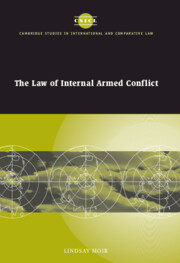Book contents
- Frontmatter
- Contents
- Preface and acknowledgements
- Table of cases
- Table of treaties and other international instruments
- 1 The historical regulation of internal armed conflict
- 2 Article 3 common to the Geneva Conventions
- 3 Additional Protocol II of 1977
- 4 Customary international law and internal armed conflict
- 5 Human rights during internal armed conflict
- 6 Implementation and enforcement of the laws of internal armed conflict
- Bibliography
- Index
- CAMBRIDGE STUDIES IN INTERNATIONAL AND COMPARATIVE LAW
3 - Additional Protocol II of 1977
Published online by Cambridge University Press: 07 July 2009
- Frontmatter
- Contents
- Preface and acknowledgements
- Table of cases
- Table of treaties and other international instruments
- 1 The historical regulation of internal armed conflict
- 2 Article 3 common to the Geneva Conventions
- 3 Additional Protocol II of 1977
- 4 Customary international law and internal armed conflict
- 5 Human rights during internal armed conflict
- 6 Implementation and enforcement of the laws of internal armed conflict
- Bibliography
- Index
- CAMBRIDGE STUDIES IN INTERNATIONAL AND COMPARATIVE LAW
Summary
Common Article 3 stood alone in the sphere of internal armed conflict for twenty-five years, but, as demonstrated, it had become evident that some amendment or clarification of the rules governing internal conflicts was necessary, since:
When put to the test … the rules of protection in [common] Article 3 had been shown to require elaboration and completion. Government and Red Cross experts consulted by the ICRC since 1971 had confirmed the urgent need to strengthen the protection of victims of non-international armed conflicts by developing international humanitarian law applicable In such situations.
The decision was therefore made to improve the law, and following several conferences of Governmental Experts and ICRC representatives, two Additional Protocols were drafted and placed before the Diplomatic Conference on the Reaffirmation and Development of International Humanitarian Law Applicable in Armed Conflicts, held in Geneva from 1974 to 1977.
Although this book is concerned with internal conflict, and so with Protocol II (the 1977 Protocol Additional to the Geneva Conventions of 12 August 1949, and Relating to the Protection of Victims of Non-international Armed Conflicts), Additional Protocol I is still of relevance.
- Type
- Chapter
- Information
- The Law of Internal Armed Conflict , pp. 89 - 132Publisher: Cambridge University PressPrint publication year: 2002
- 1
- Cited by



